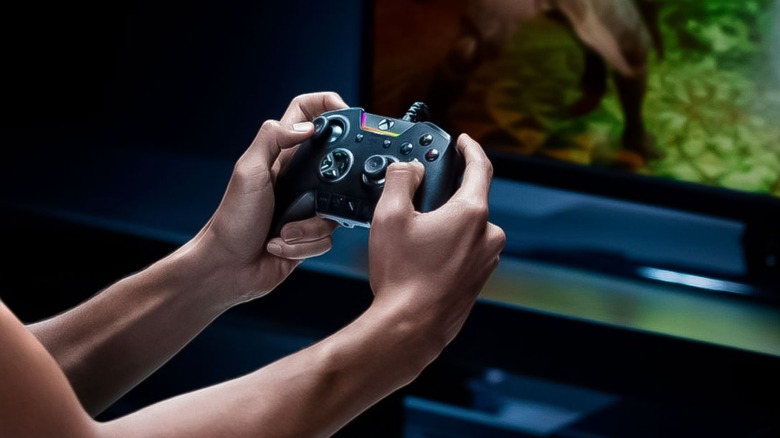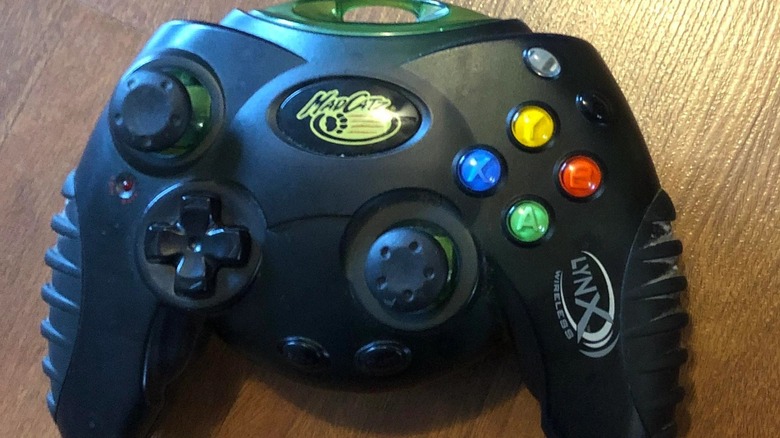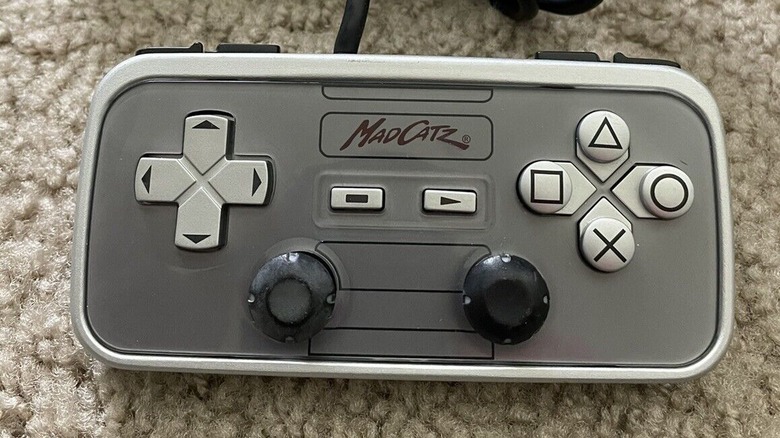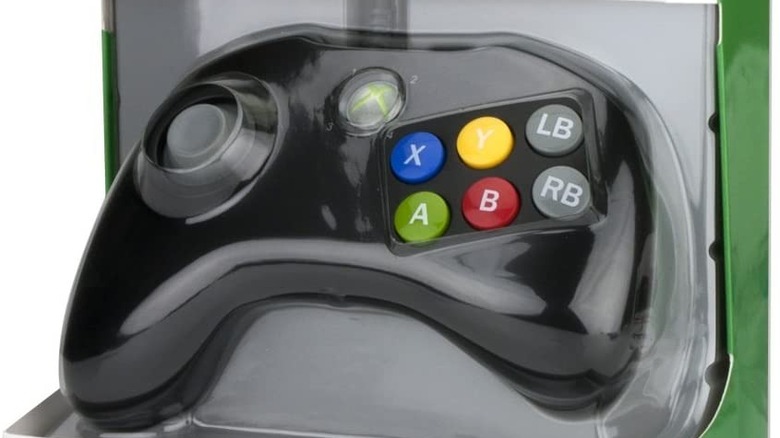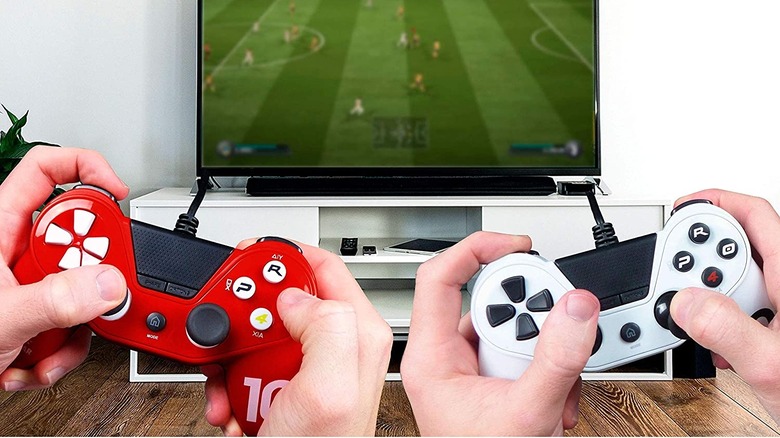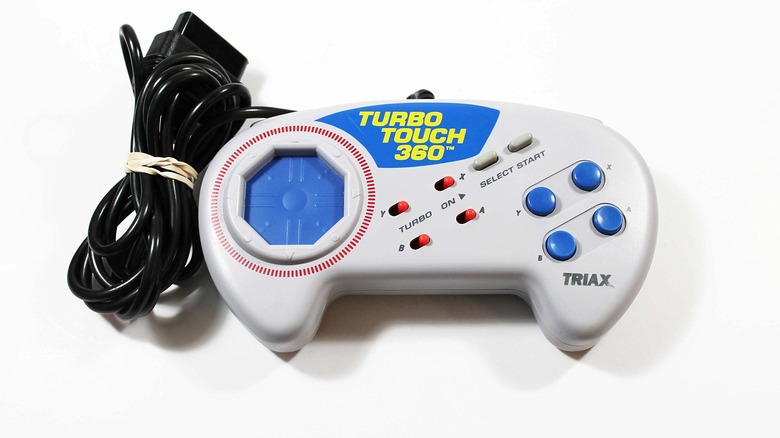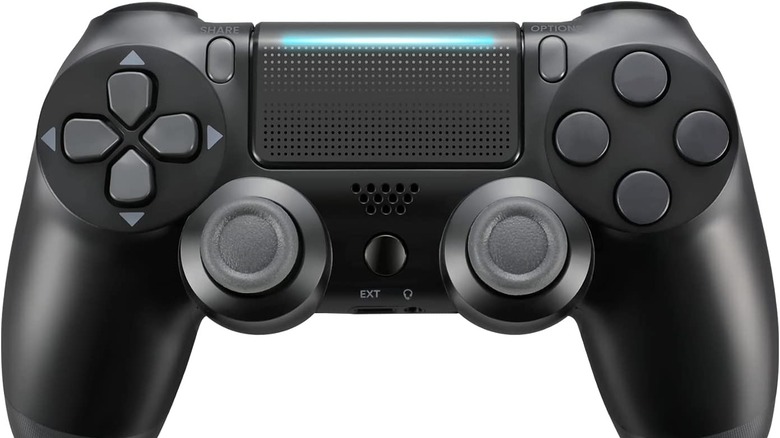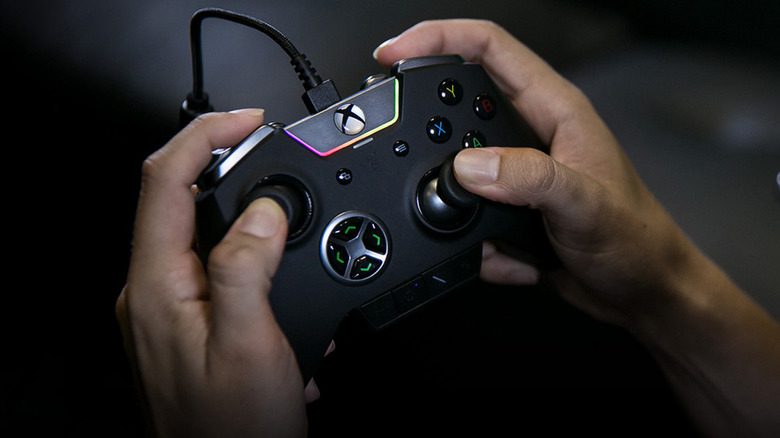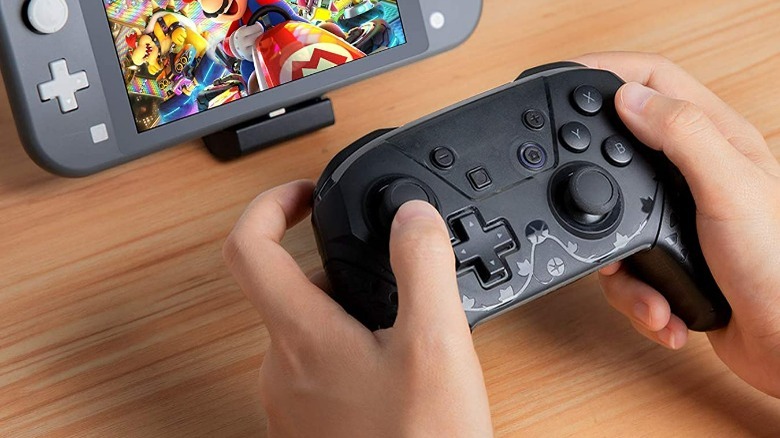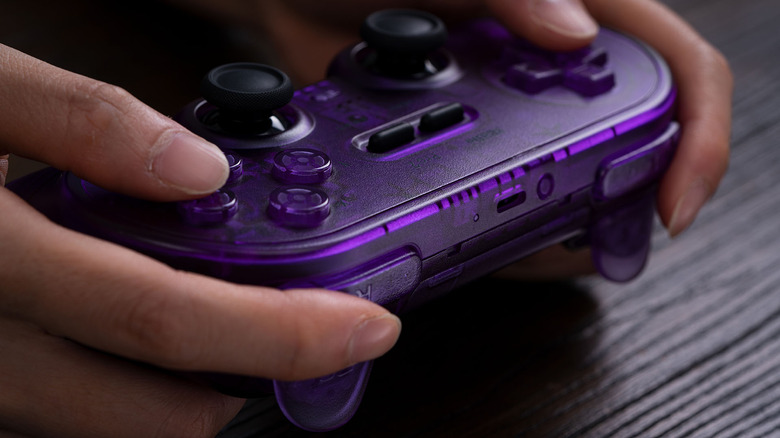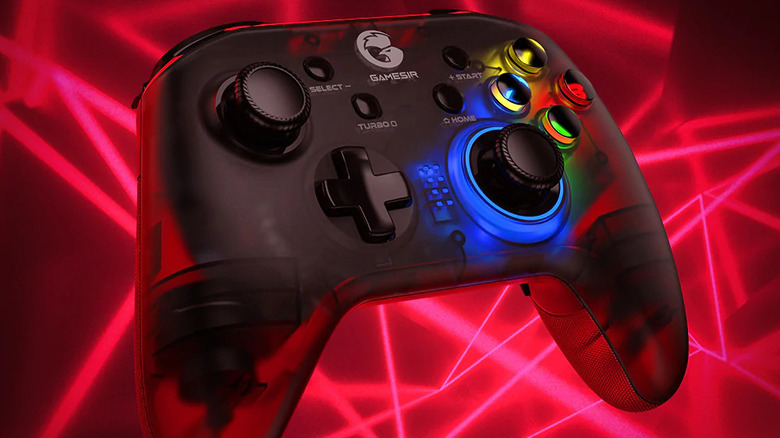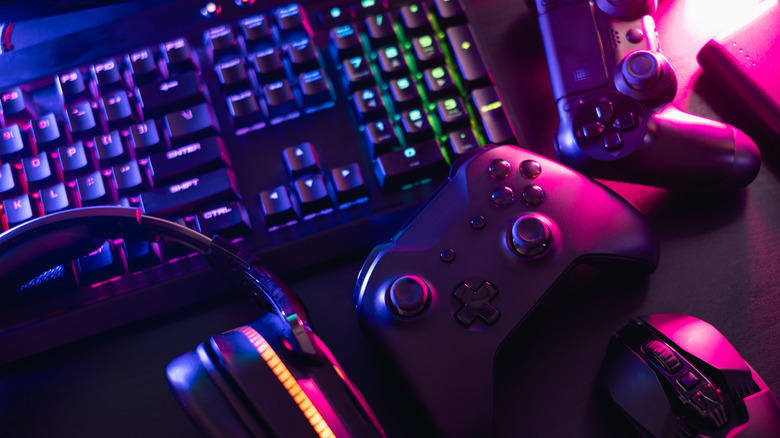The 5 Best And 5 Worst Third-Party Video Game Controllers
We may receive a commission on purchases made from links.
Videogame controllers have a storied history, starting off with a simple joystick from the days of ping pong to the iconic rectangular NES/SNES pads, evolving into the popular Xbox, PlayStation, and Nintendo Switch controllers of our modern era.
As console makers experimented with different types of control schemes, buttons, and interfaces to develop and improve the gaming experience on their respective devices, third-party controllers hopped onto the scene with companies offering their own take on famous ergonomic designs. Some simply cost less than the originals, while others add features that either improve the player experience or end up being no more than snake oil gimmicks to hook in unsuspecting buyers.
Just like the original controllers, third-party video game controllers also range from great (Razer's ultimate Xbox controller) to being a massive waste of money (the $200+ Wu-Tang Shaolin Style controller being a great example).
In this article, we'll look at some of the best and worst off-brand video game controllers and what made them oh-so-great or downright atrocious. As we begin, keep in mind that just because this list includes a particular controller, you don't need to feel bad if you like using it.
Mad Catz Original Xbox Lynx Wireless - Worst
Remember the original Xbox which had a "unique" design aesthetic? Emphasis on the word unique, as the first Xbox controller was too big, 3 times larger than its rival PlayStation 2 controller, had every type of functionality crammed in even though it didn't need most of them, and was quite ugly overall.
One would think, this seems like the perfect opportunity to make a 3rd party controller with a better design, not crammed full of stuff you don't need. Mad Catz thought it could do better, and some of its ideas with the Lynx wireless controller were on the right track — but the end result didn't really pan out.
This controller was slightly less bulky than the original and had a better d-pad and button layout while also having wireless functionality. That's where the cons start. You could play on Lynx wirelessly but if you needed to use Xbox Live, a service need to play multiplayer games online, you'd need a cord to connect the controller to the console.
Two other small things to note here were that the joysticks got quite slippery if you used them for a while, and the triggers were quite stiff. The triggers could suffice for racing games but for other types of games, they could get quite difficult to use especially if you used them often like in a fighting game for instance. The original Xbox ended up not doing so hot after its launch which meant that this controller was also doomed to fail.
Mad Catz RetroCon - Worst
PlayStation 2 is one of the best-selling video game consoles ever made, and more than a small part of the reason was its top-tier controller. There wasn't much room for improvement, but that didn't stop Mad Catz from trying to reinvent the wheel. The RetroCon was a cute little thing with an obvious nod to the NES gamepads and it did get a few things right, however, it was also a step backward in terms of functionality in a few key areas.
Starting off with the good, the RetroCon was light and the ergonomics were on point as it was comfortable to hold. The joysticks were especially good considering the size of this thing and had just the right amount of tension and movability. It could also light up, making it easier to game at night.
As for the bad stuff, the D-pad was an obvious one. It looked fine, but you had to press it down really hard for it to register in-game, which meant that using the D-pad was quite slow and cumbersome. Another major downside was the implementation of shoulder buttons and triggers, both of which were too small. Plus, there were no L2/R2 triggers for analog input, especially useful in racing games, you had to make do with clicky buttons instead. Using them also took some getting used to.
PDP Versus Fight Pad - Worst
Even though original console controllers worked just fine for fighting games, that didn't stop peripheral makers from trying out different button and stick layouts for them. One of the more popular layouts is pictured above, a stick alongside 6 buttons that were mapped to different punches/kicks or special moves depending on your game. Modeled after the arcade cabinets from the '90s, these controllers were supposed to make the transition from arcades to consoles for veteran fighting game players easier. Unfortunately, it didn't work out so well for PDP Versus Fight Pad which had a few glaring issues.
The larger buttons were nice to have, as you wouldn't accidentally press the wrong one with your thumb during intense gaming sessions, but they were low quality and rattled in place. In fact, the overall build quality wasn't all that great, the rubberized coating on the back degrades quite easily and has to be cleaned off with rubbing alcohol.
Another downside was the arcade stick-like thumbstick, which had 6 micro switches to emulate its arcade counterpart. It felt nice to use, but only after a steep learning curve.
Granted, this is a controller made specifically for a single purpose — fighting games — but any game you're attempting to play that needed a D-pad wasn't going to work, as PDP simply didn't include one.
Subsonic Pro 4 Soccer PS4 Controller - Worst
As far as cheap knock-off controllers go, this not only looks bad, it lacks features too.
The Pro4 Soccer Wired Controller for PS4 is still available as new today in both wired and wireless options. Apart from looking like a janky, poorly designed controller (why would you replace the X, circle, square, and rectangle with your own controller's name?), it gets bonus points for lacking one of the most basic features on a PS4 controller a headphone jack.
Sure, you may be one of the few that don't need a headphone jack, but can you live without the PS button? The "home" button on this controller can only take you out of the game and doesn't turn on your PS4 or provide additional benefits you get from it while also lacking motion controls that are vital to playing some of the games like Until Dawn.
See if you can find the Share and Options buttons on this controller; they're placed right next to the joysticks and it's very easy to miss them. The touchpad is also tiny and might also present a problem in some games where you need to swipe or tap on it and there is no lightbar to speak of.
If all of these reasons weren't enough, reviews on Amazon suggest the wireless version disconnects every 10-15 minutes, some of the buttons fail to work, and on occasion, the controller is said to die after only a few uses.
Triax Turbo Touch 360 - Worst
This one's from an era where third-party controllers were truly wild and featured odd shapes and buttons just to stand out.
Triax's Turbo Touch 360 was one of the first controllers that had a touch interface as opposed to sticks and buttons that nearly every controller had back in the day. The idea here was to reduce strain on your thumb, with the marketing material claiming that it would fix the "numb thumb" problem that regular D-pad controllers caused. It also claimed that you could use it for "faster movement for high scores", offering a money-back guarantee saying that if you couldn't improve your high scores within 30 days, you'd get a full refund.
As for its in-game usability, it worked fine for some games but in platformers you were likely to hit diagonal inputs accidentally, causing wonky movement. In other types of games where you can use circular movement, the Touch 360 had a bit of a delay in response times. Fighting games also presented a problem as you'd often rest your thumb in the middle but get an accidental directional input which could cost you important rounds in a match.
These days touch controls have been improved quite a bit on controllers but at the time, games weren't designed to make use of them, meaning Triax Turbo Touch 360 was ahead of its time despite being a bad controller when launched. So we've got a sort of "so bad it's good" sort of situation going on here as we head into the five best third-party controllers.
Medvoe Wireless PS4 - Best
What makes a good third-party/off-brand controller good? It should either go above and beyond the original controller by adding more functionality, or it should do everything the original can do, but at a lower price. Medvoe's PS4 controller falls in the latter category.
From a near-identical design to the Sony DualShock 4 to its having motion controls, a mic/speaker, a touchpad, and a working PS button (unlike the Pro4 controller we discussed earlier in this article), you get your money's worth with this one. Available for around $18 apiece on Amazon, it massively undercuts the DualShock 4 in terms of pricing.
Do note that this isn't a perfect copy with minor drawbacks like the buttons being a little bit stiffer and the joysticks having a bigger dead zone, which might be noticeable if you play first-person shooter games.
Another significant quirk is that the shoulder buttons and triggers have been combined, meaning L1 and L2 are connected even though they have separate triggers. All other features and functions are virtually identical to the DualShock 4 and you get a micro USB cable with the packaging.
If you're looking for an affordable replacement for your broken PS4 controller, this is a great option, though you'll have to settle for the colors the manufacturer offers.
Razer Wolverine Ultimate - Best
Going from one side of the good controller spectrum to the other, this one goes a step above even the Xbox One Elite controller.
Razer's Wolverine Ultimate makes an already good controller better by adding customizable joysticks and D-pad, which connect via magnets meaning they can be swapped quite easily and don't require additional tools or tinkering. There are also 6 additional buttons that players can customize to their liking, 4 located near the bottom of the controller and 2 at the back next to the shoulder buttons and triggers.
Razer has a dedicated Synapse app that allows you to tinker with the Wolverine Ultimate further. You can assign different functions to the additional buttons, customize the lighting effects, and adjust the sensitivity of the joysticks to your liking. The haptic feedback sensitivity can also be customized with each motor being individually controllable through the Synapse app.
It all sounds too good to be true, doesn't it? Unfortunately, all of these features come at a cost. The Razer Wolverine Ultimate costs an eye-watering $150, a full fat $110 above the original Xbox One controller's price (at the time of writing). However, you can currently buy it for $100 on Amazon if you're willing to pay for that level of customization.
YCCTEAM Wireless Pro - Best
Same as the previously mentioned Medvoe PS4 Controller, YCCTEAM's Pro Wireless for Nintendo Switch does everything a Switch Controller would do but at a lower price.
This third-party controller looks quite similar to the original Switch Pro controller, but with one small change, the home button is now massive and located right in the middle making it easier to access. It can be quite useful too as it can be used to wake up your Switch and also be used as the home button just like the usual Switch Pro controller.
Most third-party Switch controllers aren't able to scan amiibo, but thankfully this one can. Just press the amiibo down on top of this controller and it scans them to unlock goodies. It does have a few small downsides though, it's a bit on the lighter side so those of you that prefer weighty controllers won't like it. The grips can also be slippery as they aren't textured.
All-in-all a great third-party controller for Switch players and at a much lower price of $27 on Amazon vs $70 for the Switch Pro controller.
8bitdo Pro 2 - Best
Summarizing everything about this controller in one word we'd call it excellent. 8bitDo is a famous third-party controller maker and Pro 2 is one of their best products so it makes sense that it'll be mentioned in the best 5 controllers on this list.
The Pro 2 works with Windows, macOS, Android, iOS, and Switch, and feels almost like a first-party controller thanks to its sturdy build. According to our own review of the Pro 2 by Eric Abent, 8bitDo has improved their already great SN30 Pro+ controller with quality-of-life improvements like being able to assign and switch profiles on the fly and letting you change input types directly through a button underneath the controller.
Simple input switching is especially a useful upgrade as you'd need to press and hold a couple of buttons to change inputs in the SN30 Pro+. It also features a removable battery in case you need to replace it at any point down the line. On the subject of battery, the battery life is rated at 20 hours which is amazing as far as controllers go, especially ones with lighting and motion controls.
Like the Razer Wolverine Ultimate, 8bitDo Pro 2 can also be customized quite extensively using its software tool, which is now also available on mobile devices if you mostly game on your phone. The only downside to this controller is its lack of NFC and HD Rumble, something that you can get from YCCTEAM's Wireless Pro which can do it all.
Gamesir T4/T4 Pro - Best
Last but by far not least is Gamesir's T4 Pro which is quite similar in functionality to the previously mentioned 8bitDo Pro 2, but comes at a considerably lower price ($35 vs $50).
It looks like a mix of an Xbox and a Nintendo Switch Pro controller in terms of design and button layout. As for input types, it works with PC, Android, iOS, and Switch. For PC you'll need to use the provided Bluetooth dongle or the charging cable while for the other platforms you can simply pair the controller directly via Bluetooth. Like the 8bitDo Pro 2, the T4 Pro also lets you customize the sensitivity of the joysticks and map different actions to various buttons to your liking, including rear buttons next to the left and right triggers. You can also tune the haptic feedback motors to different vibration intensities and change the lighting on the buttons, a small but important feature for nighttime gaming sessions.
Another thing to note here is that Gamesir provides a phone holder if you plan to use the controller with your phone, which is nice to have as well. As for the battery life, it's not quite up there with the likes of 8bitDo's Pro 2, but it can hold its own with 15-18 hours of usage.
One small caveat with the Gamesir T4 Pro is that it doesn't retain Bluetooth pairing between different devices which can be a hassle if you plan to use it on multiple platforms.
Final Thoughts
Now that you've gone through the whole list of best/worst third-party controllers you might be wondering, what happened to Wu-Tang? We have a few runner-up contestants here, as well.
Some of the runner-ups include controllers like the Wu-Tang PS2 controller that was launched alongside the PS2 brawler game of the same name, as it was barely usable and was likely meant to be purchased as a sort of a display piece. Then there's Hori Mini Wired gamepad for PS4 that looked cute but lacked several important features. For Xbox, SCUF Prestige is also a highly customizable controller but also costs a lot.
If you're looking to buy a third-party controller, keep in mind that it should either match or offer more features than the original ones. You can also get ones that are cheaper and get the job done — but try to avoid unknown brands as there's no guarantee on how long they'll last. To be on the safe side, check reviews before buying them to know what you're getting into.
